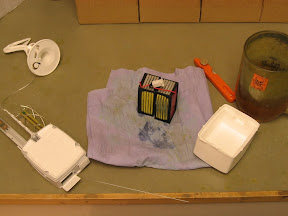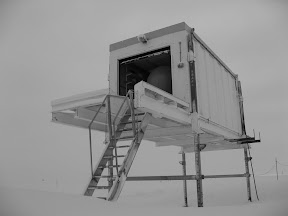Launching a Weather Balloon
Every day, weather balloons are launched from sites across the globe. The helium filled balloons carry miniature electronic instrumentation to measure temperature, humidity, pressure and wind speed and direction.
A radio transmitter sends back data directly to the ground station - trying to find a small white box on the Antarctic icesheet would be more trouble than it's worth, even though they cost about £150 each!
Data from our balloon flights is sent directly to the Met Office in Exeter where it is used to check the output from global weather models, helping to answer the all important question - "is the weather doing what the model says it is?". Data from the flight is then used to fine-tune the model for the next 24 hours.
This is how we do it.
1. Open the box, check the Sonde and put the battery in to soak

The Sonde Kit
2. Configure the Sonde to local conditions. The computer calibrates all the on-board sensors to local parameters. We also enter the cloud cover and weather conditions.

Configuring the sonde
3. Wrap up warm and walk over to the BART platform. Here we fill the weather balloon with helium and attach the sonde using a hi-tech piece of string. The balloon is filled with just enough gas to lift a 1kg weight. This controls its rate of assent such that it passes through the important 100hPa at 12:00 GMT.

Tying the sonde on
4. Launch! At 11:00GMT precisely, the door is opened and the balloon launched. This is easy on a still day, but when the wind gets up a vacuum is formed across the top of the container, dragging the balloon out. Flights often reach over 22,000m, the balloon expanding to the size of the container before popping!

Ready to launch!
Data is send back to the configuration computer throughout the flight. When completed, we check it's looking sensible, add error bars and local parameters and send it off to the Met Office.
That's a day in the life of a weather balloon.
Oh, while on the subject of weather, it's a new record low for the season at -38.0C !!
A radio transmitter sends back data directly to the ground station - trying to find a small white box on the Antarctic icesheet would be more trouble than it's worth, even though they cost about £150 each!
Data from our balloon flights is sent directly to the Met Office in Exeter where it is used to check the output from global weather models, helping to answer the all important question - "is the weather doing what the model says it is?". Data from the flight is then used to fine-tune the model for the next 24 hours.
This is how we do it.
1. Open the box, check the Sonde and put the battery in to soak

The Sonde Kit
2. Configure the Sonde to local conditions. The computer calibrates all the on-board sensors to local parameters. We also enter the cloud cover and weather conditions.

Configuring the sonde
3. Wrap up warm and walk over to the BART platform. Here we fill the weather balloon with helium and attach the sonde using a hi-tech piece of string. The balloon is filled with just enough gas to lift a 1kg weight. This controls its rate of assent such that it passes through the important 100hPa at 12:00 GMT.

Tying the sonde on
4. Launch! At 11:00GMT precisely, the door is opened and the balloon launched. This is easy on a still day, but when the wind gets up a vacuum is formed across the top of the container, dragging the balloon out. Flights often reach over 22,000m, the balloon expanding to the size of the container before popping!

Ready to launch!
Data is send back to the configuration computer throughout the flight. When completed, we check it's looking sensible, add error bars and local parameters and send it off to the Met Office.
That's a day in the life of a weather balloon.
Oh, while on the subject of weather, it's a new record low for the season at -38.0C !!



0 Comments:
Post a Comment
<< Home